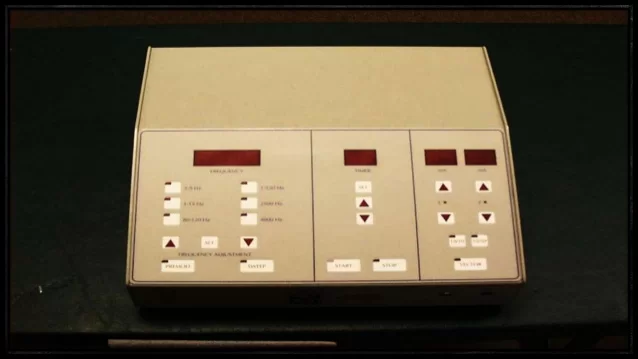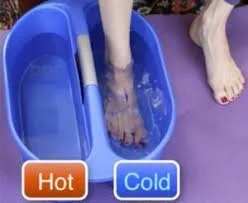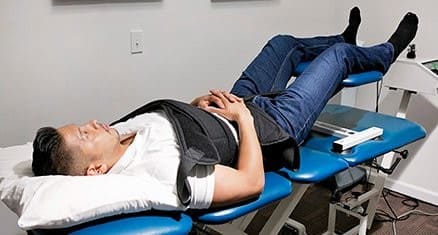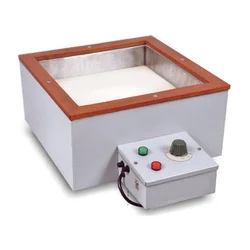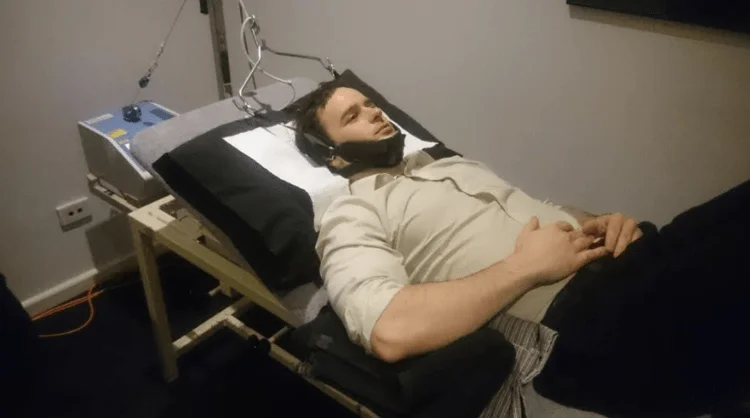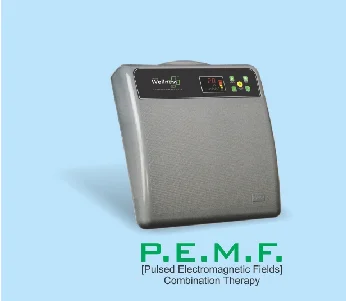Russian Current
What is a Russian Current?
The Russian Current, also known as Kotz-Current, is a form of electrical stimulation that utilizes medium-frequency currents to produce therapeutic effects in physical therapy and rehabilitation. Named after its origin in Russian medical research, the Russian Current typically operates at a frequency of 2,500 Hz and is modulated to create a series of bursts, which are believed to effectively stimulate muscle contractions.
It was proposed that using it considerably (about 30–40%) enhanced muscle strength. There were published claims in 1970 that the Russian current or 2500 Hz medium frequency interrupted current, could cause a contraction of muscles stronger than the maximum voluntary contraction.
This interruption results in a 50 Hz low-frequency stimulation of any kind, which activates the nerves although representing a medium-frequency current. Russian current consists of 2500 Hz medium frequency current delivered in sequential bursts with pulse durations of 0.2 ms (200 µs). The current is interrupted every 10 ms (1000 µs) when there is no current flow, resulting in 50 bursts per second (50 Hz), which is similar to low-frequency faradic current.
The use of this current is theoretically justified by the fact that virtually all of a muscle’s motor units can be stimulated to their maximum potential electrically to do something that cannot be done through voluntary contraction. Increased muscle contraction results from this, which leads to hypertrophy.
Features of current in Russian:
- Waveform
- carrier frequency
- current amplitude
- frequency and duration of bursts
- duty cycle
- on/off ratio
- ramp up and down
- training regimen
- length and frequency of treatments;
- electrode placement
- time delay switch
Carrier frequency: 2.5 KHz/2,500 HZ
Wave: A polyphasic sinusoidal wave best describes its shape.
Current amplitude: The absolute maximum possible current intensity is 100 mA. 70 mA in a clinical setting.
Frequency of bursts: 50 Hz
Burst duration: 10 ms
ON/OFF ratio: The on-off ratio, which is specified as 10 ms:10 ms, is the ratio of the time there is stimulation (contraction) to the time there is no stimulation (no contraction).
Ramp up and down: Timing the ramp is critical for triggering a contraction similar to that of a muscle because the ramp enables a progressive rise in intensity and, hence, a progressive increase in muscular contraction. For one to two seconds.
Training regimen using Russian current: The most widely-used and well-liked clinical regimen with Russian current is (10/50/10), which is,
- 10 signifies ten seconds of muscular contractions.
- 50=off times for 50 seconds (with no contraction)
- Ten cycles are repeated ten times.
frequency and length of therapy: it is advised that patients receive treatment once a week for a few weeks (three to six months) for 10 minutes.
Electrode placement: aligned perpendicular to the path of muscle fibers, at the approximate muscle pull line.
Time delay switch: synchronous mode (achieved by not setting a time delay, which causes both channels to trigger simultaneously) Reciprocal mode, which is achieved by setting the time delay to match the duration of channel 1; if channel 1 is active, channel 2 is inactive. overlap mode (achieved by setting a time delay greater than one second but less than that of channel 1), in which channel 2 overlaps with channel 1’s on-and-off times.
Protocols for Russian current:
Protocol for hypertrophy and muscle strengthening:
- Amplification/Intensity: contraction of the tetanic
Apply current when engaging in voluntary activities. - Pulse rates range from 50-70 Hz, with durations of 150-200 µs.
- Isometric exercises can be performed at various positions across the range of motion.
5 to 10° per second is an exercise in slow isokinetics (movements in the same direction).
When the range of motion is restricted, joints move in a small arc.
Method for reducing muscle spasms:
- Tetanic contraction amplitude based on patient tolerance
- Surge frequency: 50–70 Hz
- Duration of pulse: 50–175 µs
- Isometric contraction of muscles
Physiological effects of Russian current:
- the total amount of bursts given in a second.
- The Russian current can depolarize
- Sensory nerve fibers: mild tingling feeling
- contraction of the tetanic muscle by motor nerve fibers
Because the pain gate is blocked by the sensory nerve, this contraction is painless. - Permit the application of high amplitude:
- contraction more powerful than that produced by voluntary control (motor units are recruited asynchronously during voluntary contraction, whereas they fire synchronously during electrically evoked muscle contraction).
Therapeutic effects/protocol of Russian current:
1) improve muscle strength:
Tetanic muscular contraction to increase muscle strength and amplitude
Burst frequency (pulse rats): 150–200
apply current while making a voluntary isokinetic, short arc movement, and isometric in various ROM slow speeds
2) to lessen the amplitude of a muscle spasm:
tetanic muscle contraction up to the patient’s pulse rate tolerance of 50–175 stimulation is used to produce a quick isometric contraction that lasts 8–15 seconds on and 5–12 seconds off.
3) to lessen edema (caused by a failure to contract muscles).
Pulse rate: 35–50 Hz; amplitude: little discernible muscular contraction
pulse duration: around 400 ms One to two seconds of inactivity Muscle pumping occurs about 1-2 seconds.
Ten to fifteen minutes for treatment.
Indications of Russian current:
According to Kots’ 1977 introduction, the sole indication for using Russian current is to fortify the muscular system in those who are in good health and athletic person.
- following surgery on the knee ligaments
- after arthroscopic knee surgery
- sprained ligament
- after casting
- muscular spasm
Contraindications of Russian current:
- Arrhythmias and cardiac pacemakers
- hemorrhagic illness
- Thrombosis and thrombophlebitis (vein wall inflammation)
- Early tendon replacement and restoration
- on the pelvis, lower back, and abdomen during pregnancy
- unconscious individual
- Recently, radiation therapy
- the carotid sinus
- A young person experiencing mental health issues
- Cancer
Precautions of Russian Current :
Russian current, a kind of electrical muscle stimulation (EMS), has therapeutic advantages, but there are several precautions to take:
- Skin irritation: Russian currents can cause skin irritation or burns if the electrodes are not properly positioned or the intensity is too high.
- Improper current flow: Ensure that electrodes are properly placed to avoid current bypassing the desired tissues.
- Pain or discomfort: If you suffer pain or discomfort during treatment, discuss it with your therapist so that the intensity can be adjusted.
Summary:
Russian current is an electrical stimulation technique used in physical therapy to strengthen and rehabilitate muscles. Here is a summary:
- Medium-frequency alternating electricity, delivered in bursts.
- During 50 Hz bursts, the frequency is often 2500 Hz.
- Effect: Causes intense muscular spasms.
- Applications include muscular strengthening, reduction of muscle spasms, and edoema.
- Treatment normally consists of 10-second bursts separated by a 50-second rest period.
All things considered, Russian modern technology enhances and increases muscle function.
FAQ’s
What exactly is the Russian current utilized for in therapy?
it is used to developed to speed up muscle recovery, grow larger, more durable muscles, and strengthen existing ones. It makes use of high-frequency, sinusoidal electrical waveforms, just like EMS.
What are the impacts of the Russian current?
This might be explained by the fact that the Russian current induces practically all of the muscle’s motor units to contract simultaneously, resulting in increased muscular development.
What is the physiology of the Russian Current?
Six The most immediate physiological response to HVPGC is electrochemical alterations at the cellular and tissue levels. At the cellular level, Russian current has the greatest physiological effect. Furthermore, the stimulus-rest ratios at which these two currents are delivered are usually different.
What is Russia’s current waveform?
The conventional Russian current has a sinusoidal waveform with a duration of the pulse of 0.4 ms (400 us), a carrier frequency that is 2500 Hz, a modulation frequency of 50 Hz, and a duty cycle of 50%. Ten emissions and ten milliseconds of pause
Why is it called Russian stimulation?
Dr. Yakov Kots, a Soviet scientist, was one of the first to advocate for the use of EMS in sports, hoping to raise the fitness levels of USSR Olympic players during the games.
What other names does Russian current go by?
Electromyostimulation employing Russian currents, also known as Kotz currents, may enhance muscular strength.
What is the Russian current protocol?
Russian current represents a medium-frequency electrical current that occurs in bursts at 2500 Hz. It causes powerful muscular contractions by synchronous motor nerve depolarization. The usual protocol consists of 10 contractions lasting 10 seconds each, followed by 50-second rest intervals, and repeated 10 times.
References
- Dhameliya, N. (2023, October 27). Russian Current: Physiological Effects, Indication, Contraindication. Samarpan Physiotherapy Clinic. https://samarpanphysioclinic.com/russian-current-use-in-physiotherapy/
- Vastralphysiotherapyclinic. (2023, November 19). Russian Current: Protocols, Indication, Contraindication. Mobility Physiotherapy Clinic. https://mobilephysiotherapyclinic.net/russian-current/

